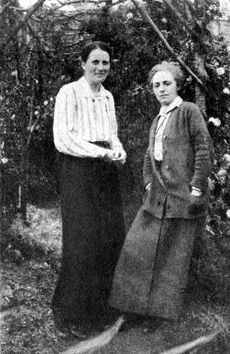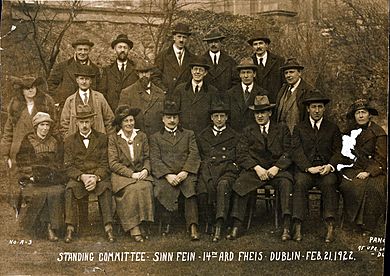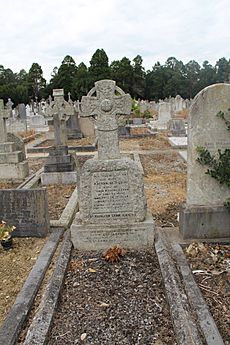Kathleen Lynn facts for kids
Quick facts for kids
Kathleen Lynn
|
|
|---|---|

Lynn as she appeared in a 1927 piece of election material
|
|
| Vice President of Sinn Féin | |
| In office 1923–1927 |
|
| Leader | Éamon de Valera |
| Teachta Dála | |
| In office August 1923 – June 1927 |
|
| Constituency | Dublin County |
| Personal details | |
| Born | 28 January 1874 Killala, County Mayo, Ireland |
| Died | 14 September 1955 (aged 81) |
| Education | Alexandra College |
| Alma mater | Royal University of Ireland |
| Military service | |
| Branch/service | Irish Citizen Army |
| Rank | Captain/Chief Medical Officer |
| Battles/wars | Easter Rising |
Kathleen Florence Lynn (born January 28, 1874 – died September 14, 1955) was an amazing Irish doctor, a brave activist, and a politician with Sinn Féin. She dedicated her life to helping others, especially children.
When she was 16, Kathleen saw how much suffering poverty and sickness caused in Ireland. This made her decide to become a doctor. She studied in England, Germany, and at the Royal University of Ireland. After finishing her studies in 1899, she worked in the United States for ten years. She then came back to Ireland and became the first female doctor at the Royal Victoria Eye and Ear Hospital in 1910. A big achievement was founding Saint Ultan's Children's Hospital in 1919.
Contents
Early Life and Family
Kathleen Lynn was born on January 28, 1874. Her family lived in Mullafarry, near Killala in County Mayo, Ireland. Her father, Robert Young Lynn, was a clergyman in the Church of Ireland. Her mother was Catherine Wynne. Kathleen was the second of their four children.
In 1882, her family moved to Shrule in County Longford. Her father became the clergyman for the Ballymahon area. Later, in 1886, they moved to Cong, a village between Mayo and Galway.
Growing Up in Ireland
Kathleen went to Alexandra College in Dublin until she was sixteen. This school was supported by Lady Ardilaun of Ashford Castle. She was also related to Countess Markievicz through her aunt.
Kathleen grew up after a very difficult time in Ireland called The Great Famine (1845 – 1852). She was very sad to see how many people suffered from deadly diseases and poverty. This experience strongly influenced her. When she left school at 16, she knew she wanted to become a doctor to help people.
Her family did not agree with her involvement in the Easter Rising. They were so upset that they would not let her come home for Christmas in 1917. Instead, she spent Christmas with her aunt in Dublin. This disagreement with her family was resolved before her father passed away in 1923.
Kathleen lived in Rathmines, Dublin, from 1903 until she died in 1955. She shared her home with her close friend and colleague, Madeleine ffrench-Mullen. She also had a holiday cottage in Glenmalure, County Wicklow. When she died, she left this cottage to An Óige, which is the Irish youth hostel association.
Education and Medical Training
In 1891, Kathleen attended Alexandra College in Dublin. She finished her studies there in 1893. She then went on to the Royal University of Ireland.
From 1897, Kathleen took medical classes at the Catholic University of Ireland and the Royal College of Surgeons of Ireland. In 1898, she won an important prize for anatomy. She graduated as a doctor from the Royal University of Ireland in 1899.
Early Medical Career
Kathleen gained experience at several hospitals. These included Holles Street Hospital, the Rotunda Hospital, the Royal Victoria Eye and Ear Hospital, and the Richmond Lunatic Asylum. In 1898, she was offered a job as the first woman resident doctor at Dublin's Adelaide Hospital. However, other staff members did not want a woman in that role, so she could not take the job.
She continued her medical training in the United States in the early 1900s. After returning to Dublin, she worked as a doctor in hospitals and had her own general practice. In 1909, she became a fellow of the Royal College of Physicians of Ireland. She was also promoted at the Royal Victoria Eye and Ear Hospital that same year.
Political Activities and the Easter Rising
Kathleen Lynn was involved in many important movements. From 1903, she was a member of the Irish Women's Suffragette and Local Government Association. This group worked to get women the right to vote. She was also part of a British group called the Women's Social and Political Union from 1908.
In 1912, she joined a large meeting. They demanded that women's right to vote be included in a new law for Ireland.
Supporting Workers and Nationalists
Kathleen supported workers during the 1913 lock-out. She worked with Constance Markievicz and others to provide food in soup kitchens. During this time, she became good friends with Markievicz and James Connolly.
In 1913, she treated Helena Molony, who was active in political groups. Molony stayed with Kathleen at her home. Through Molony and Markievicz, Kathleen became very active in the movements for women's rights, workers' rights, and Irish independence. She wrote that these talks "converted me to the National Movement."
She joined the Irish Citizen Army (ICA). During the 1916 Easter Rising, she was the chief medical officer. When she was arrested, she bravely said she was "a Red Cross doctor and a belligerent."
After the Rising
For her part in the Rising, Kathleen was held in Kilmainham Gaol. Her friends and fellow activists, Markievicz, Molony, and Madeleine ffrench-Mullen, were also there.
Kathleen stayed active in the movement for Irish independence. In 1917, she was elected vice-president of the Sinn Féin executive. In 1923, she was elected to Dáil Éireann (the Irish parliament) as a Teachta Dála (TD) for Dublin County. She was part of the anti-Treaty Sinn Féin group.
However, following Sinn Féin's policy at the time, she did not take her seat in Dáil Éireann. She lost her seat in the June 1927 election. She tried again in a by-election in August 1927 but was not successful. Kathleen later said that fighting for women's right to vote made her understand the fight for Irish independence. The Irish Citizen Army gave her a special gold brooch to thank her for her medical help during the Rising.
Kathleen left politics in 1927. She was becoming frustrated that Sinn Féin was not focusing enough on social reforms and healthcare.
Medical Career and Saint Ultan's Hospital
Kathleen Lynn decided to become a doctor when she was 16. She was one of the first women to graduate from University College Dublin with a medical degree. She became politically active and helped poor families during the 1913 Dublin Lock-Out by providing food and care.
Her most important medical work was at Saint Ultan's Children's Hospital. She opened this hospital in Dublin in 1919 with other women activists. Kathleen had seen how much poor mothers and babies in Dublin needed medical help and education.
A Hospital Run by Women
Earlier in her career, Kathleen had faced unfair treatment because she was a woman applying for hospital jobs. Saint Ultan's was special because it was the only hospital in Ireland completely run by women.
Saint Ultan's Hospital grew quickly. From 1937, it became the main place in Ireland for BCG vaccinations. These vaccinations help protect against tuberculosis. The hospital continued its important work until it closed in 1983.
Kathleen was also the chief medical officer for the Irish Citizen Army. James Connolly, a leader of the rebels, asked her to join the ICA during the 1916 Rising. She was made a Captain and Chief Medical Officer. She trained ICA members in first aid and also taught the Cumann na mBan, a women's organization.
Dr. Lynn believed in using the Irish language. She, along with writer Sean O'Casey, encouraged the use of Irish in Church of Ireland services. Many events for Saint Ultan's Hospital were advertised in Irish.
Death and Lasting Impact
Kathleen Lynn passed away on September 14, 1955. She was buried in the family plot at Deansgrange Cemetery. She received a full military funeral to honor her important role in the Rising and the War of Independence. Many people in Dublin lined the streets to show their respect for her.
After Kathleen's death, Éamon de Valera started the Kathleen Lynn Memorial Committee. This committee worked for eight years. In 1964, a new surgical unit was opened at Saint Ultan's Children's Hospital because of their efforts. However, the committee ended in 1975 due to money problems.
Her Diaries and Legacy
Kathleen kept four detailed diaries between 1916 and 1955. A librarian named Margaret Connolly spent two years writing them out. These diaries tell us a lot about her medical work, political life, and social life. They are kept at the Royal College of Physicians in Ireland.
Her diaries were used for a 2010 documentary called Kathleen Lynn – An Dochtúir Reabhlóideach. This means "Kathleen Lynn – The Revolutionary Doctor."
Historian Margaret Ó hÓgartaigh wrote a book about her life. It is called Kathleen Lynn, Irishwoman, Patriot, Doctor (2006). Kathleen Lynn is also a character in the novel The Pull of the Stars (2020) by Emma Donoghue. This book is set in a Dublin hospital in 1918.
Images for kids
-
This photograph from March 1919 shows Lynn and ffrench-Mullen attending a party celebrating the release of Constance Markievicz from prison. Lynn can be seen to the left of centrally placed Markievicz, while ffrench-Mullen is to the left of Lynn, dressed in men's clothes.
| Party political offices | ||
|---|---|---|
| Preceded by Arthur Griffith |
Vice President of Sinn Féin with P. J. Ruttledge (1923–1926) 1923–1927 |
Succeeded by Mary MacSwiney |





